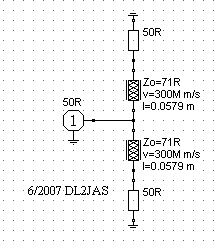Do you want to stack two yagis?.
Here is a simple solution how to connect them.

The resistors in the picture a the antennas.
Every antenna cable with the electrical length of 1/4, 3/4, 5/4... lambda transforms.
Zcable² = Zin x Zout
How does this combiner work?
The cable with its 71 Ohms transforms the 50 Ohms of the antenna to 100 Ohms.
Twotimes 100 Ohms connectet in parallel is 50 Ohms, the 50 Ohms of your transceiver. The symbol with the 1 inside is the feeding point, 50 Ohms.
You can not buy antenne cable with 71 Ohms. But you can buy antenna cable 75 Ohms, e.g. RG59 for TV sets. There is no really difference between 71 and 75 Ohms. Put 75 Ohms into the formular. The feeding point becomes 56 Ohms. It is only a little mismatch. The SWR will be 1.1.
If you calculate the transforming lines, do not forget the velocity factor. It is 0.66 for cable like RG59 and others with polyethylene.
The length of the cables in the picture ist calculated at 1.3 GHz without the velocity factor. If you want to build the combiner for micro wave, semi rigid cable 75 Ohms is a good choice.
One example.
You want to stack two short yagis for 435 MHz .
Calculate a combiner for 145 MHz. 145 x 3 = 435. The transforming lines have then a length of 3/4 lambda for 435 MHz. If RG59 is used, the length of each cable is 34 cm. If you use a cable with PTFE (velocity factor is 0.7) each cable is 36 cm long.